Effects of Pressure on Homogeneous Nucleation and Growth during Isothermal Solidification in Pure Al: A Molecular Dynamics Simulation Study
Abstract
1. Introduction
2. Methods
2.1. Simulation Model and Interatomic Potential
2.2. Simulation Details
3. Results and Discussion
3.1. Structure Evolution under Different Pressures during Isothermal Solidification Process
3.2. Effects of Different Pressures on the Nucleation Rate and Critical Nucleus Size
3.3. Effects of Pressure on Grain Growth Rate during Isothermal Solidification Process
3.4. Effects of Different Pressures on Growth Modes during Isothermal Solidification Process
3.5. Effects of Different Pressures on the Crystallite Size
4. Conclusions
- With pressure increasing, nucleation starts earlier and the number of nuclei also increases during the isothermal-solidification process. The nucleation parameters are estimated by the MFPT method. As the pressure increases, the nucleation rate increases and the change of critical nucleation size is not obvious, which are between 0.32 and 0.31 nm.
- With the increase of the pressure, the grain-growth exponent decreases, indicating that the grain growth slows down with the increase in pressure. In order to confirm the different growth modes, Avrami exponents are estimated for the isothermal-solidification process under different pressures. With the pressure increasing, the Avrami exponent decreases.
- XRD-simulation analysis reveals that with the pressure increasing, crystallite size decreases, indicating that grain can be refined under pressure. In addition, high pressure can lead to lattice deformation and even metastable-phase formation.
Author Contributions
Funding
Data Availability Statement
Acknowledgments
Conflicts of Interest
References
- Denisov, M.S. Modeling of Processes of Solidification of Metals under Conditions Imposing Pressure. Mater. Sci. Forum 2019, 945, 941. [Google Scholar]
- Tong, X.; Zhang, D.C.; Wang, K.; Lin, J.G.; Liu, Y.Y.; Shi, Z.M.; Li, Y.C.; Lin, J.X.; Wen, C. Microstructure and mechanical properties of high-pressure-assisted solidification of in situ Al-Mg2Si composites. Mater. Sci. Eng. A 2018, 733, 10. [Google Scholar] [CrossRef]
- Luo, X.; Wang, Y.; Li, Y. Role of hydrostatic pressure and wall effect in solidification of TC8 alloy. NPJ Microgravity 2019, 5, 23. [Google Scholar] [CrossRef] [PubMed]
- Bridgman, P.W. The Physics of High Pressures; Bell G. and Sons: London, UK, 1931. [Google Scholar]
- Sobczak, J.J.; Drenchev, L.; Asthana, R. Effect of pressure on solidification of metallic materials. Int. J. Cast Met. Res. 2012, 25, 7. [Google Scholar] [CrossRef]
- Fan, Z.B.; Lin, X.P.; Xu, R.; Dong, Y.; Wen, B.; Wang, L.; Zhao, S.S. Electron back-scattering diffraction preliminary analysis of heterogeneous nuclei in magnesium alloy during solidification process under GPa high pressure. J. Rare Earths 2018, 36, 185. [Google Scholar] [CrossRef]
- Liu, M.P.; Jiang, T.H.; Xie, X.F.; Liu, Q.; Li, X.F.; Roven, H.J. Microstructure evolution and dislocation configurations in nanostructured Al-Mg alloys processed by high pressure torsion. Trans. Nonferrous Met. Soc. China 2014, 24, 3850. [Google Scholar] [CrossRef]
- Andreau, O.; Gubicza, J.; Zhang, N.X.; Huang, Y.; Jenei, P.; Langdon, T.G. Effect of short-term annealing on the microstructures and flow properties of an Al-1% Mg alloy processed by high-pressure torsion. Mater. Sci. Eng. A 2014, 615, 232. [Google Scholar] [CrossRef]
- Wang, Z.X.; Lu, J.B.; Xi, Y.J.; Fan, J.W. Phase transitions of Cu-based alloys under high pressure. J. Alloys Compd. 2010, 492, 530. [Google Scholar] [CrossRef]
- Celik, F.A.; Yildiz, A.K. Molecular dynamics simulation of crystallization kinetics and homogenous nucleation of Pt-Rh alloy. J. Non-Cryst. Solids 2015, 415, 36. [Google Scholar] [CrossRef]
- Han, Y.S.; Lee, H.I.; Kim, D.H.; Kim, Y.G. Effect of applied pressure during solidification on the microstructural refinement in an Al-Cu alloy. Scr. Metall. Mater. 1994, 31, 1624. [Google Scholar] [CrossRef]
- Zhao, S.S.; Peng, Q.M.; Li, H.; Liu, B.Z. Effects of super-high pressure on microstructures, nano-mechanical behaviors and corrosion properties of Mg-Al alloys. J. Alloys Compd. 2014, 584, 58. [Google Scholar] [CrossRef]
- Mahata, A.; Zaeem, M.A. Size effect in molecular dynamics simulation of nucleation process during solidification of pure metals: Investigating modified embedded atom method interatomic potentials. Model. Simul. Mater. Sci. Eng. 2019, 27, 85015. [Google Scholar] [CrossRef]
- Sarkar, A.; Barat, P.; Mukherjee, P. Molecular dynamics simulation of rapid solidification of aluminum under pressure. Int. J. Mod. Phys. B 2008, 22, 2781–2785. [Google Scholar] [CrossRef]
- Mendelev, M.I.; Kramer, M.J.; Becker, C.A.; Asta, M. Analysis of semi-empirical interatomic potentials appropriate for simulation of crystalline and liquid Al and Cu. Philos. Mag. 2008, 88, 1725. [Google Scholar] [CrossRef]
- Daw, M.S.; Baskes, M.I. Embedded-atom method: Derivation and application to impurities, surfaces, and other defects in metals. Phys. Rev. B. 1984, 29, 6445. [Google Scholar] [CrossRef]
- Stukowski, A. Visualization and analysis of atomistic simulation data with OVITO-the Open Visualization Tool. Model. Simul. Mater. Sci. Eng. 2009, 18, 15012. [Google Scholar] [CrossRef]
- Stukowski, A. Structure identification methods for atomistic simulations of crystalline materials. Model. Simul. Mater. Sci. Eng. 2012, 20, 45021. [Google Scholar] [CrossRef]
- Chen, X.H.; Fan, W.J.; Jiang, W.W.; Lin, D.Y.; Wang, Z.D.; Hui, X.D.; Wang, Y.L. Effects of Cooling Rate on the Solidification Process of Pure Metal Al: Molecular Dynamics Simulations Based on the MFPT Method. Metals 2022, 12, 1504. [Google Scholar] [CrossRef]
- Kelton, K.F.; Gangopadhyay, A.K.; Kim, T.H.; Lee, G.W. A case for local icosahedral order in undercooled metallic liquids and the influence on the nucleation barrier. J. Non-Cryst. Solids 2006, 352, 5318. [Google Scholar] [CrossRef]
- Zhang, Q.; Wang, J.C.; Tang, S.; Wang, Y.J.; Li, J.J.; Zhou, W.Q.; Wang, Z.J. Molecular dynamics investigation of the local structure in iron melts and its role in crystal nucleation during rapid solidification. Phys. Chem. Chem. Phys. 2019, 21, 4125. [Google Scholar] [CrossRef]
- Zheng, L.Q.; An, Q.; Xie, Y.; Sun, Z.H.; Luo, S.N. Homogeneous nucleation and growth of melt in copper. J. Chem. Phys. 2007, 127, 164503. [Google Scholar] [CrossRef] [PubMed]
- Cai, Y.; Wu, H.A.; Luo, S.N. Cavitation in a metallic liquid: Homogeneous nucleation and growth of nanovoids. J. Chem. Phys. 2014, 140, 214317. [Google Scholar] [CrossRef] [PubMed]
- Wedekind, J.; Strey, R.; Reguera, D. New method to analyze simulations of activated processes. J. Chem. Phys. 2007, 126, 134103. [Google Scholar] [CrossRef] [PubMed]
- Bartell, L.S.; Wu, D.T. A new procedure for analyzing the nucleation kinetics of freezing in computer simulation. J. Chem. Phys. 2006, 125, 194503. [Google Scholar] [CrossRef]
- Wedekind, J.; Reguera, D.; Strey, R. Finite-size effects in simulations of nucleation. J. Chem. Phys. 2006, 125, 214505. [Google Scholar] [CrossRef]
- Gutzow, I.; Durschang, B.; Russel, C. Crystallization of glassforming melts under hydrostatic pressure and shear stress: Part I Crystallization catalysis under hydrostatic pressure: Possibilities and limitations. J. Mater. Sci. 1997, 32, 5390. [Google Scholar]
- Eisenstein, J.C.; Wang, L.; Cai, Y.; Wu, H.A.; Luo, S.N. Crystallization in supercooled liquid Cu: Homogeneous nucleation and growth. J. Chem. Phys. 2015, 142, 64704. [Google Scholar]
- Farag, S.; Konyashin, I.; Ries, B. The influence of grain growth inhibitors on the microstructure and properties of submicron, ultrafine and nano-structured hardmetals—A review. Int. J. Refract. Met. Hard Mater. 2018, 77, 20. [Google Scholar] [CrossRef]
- Guo, E.Y.; Shuai, S.S.; Kazantsev, D.; Karagadde, S.; Phillion, A.B.; Jing, T.; Li, W.Z.; Lee, P.D. The influence of nanoparticles on dendritic grain growth in Mg alloys. Acta Mater. 2018, 152, 130. [Google Scholar] [CrossRef]
- Najafkhani, F.; Kheiri, S.; Pourbahari, B.; Mirzadeh, H. Recent advances in the kinetics of normal/abnormal grain growth: A review. Arch. Civ. Mech. Eng. 2021, 21, 29. [Google Scholar] [CrossRef]
- Avrami, M. Kinetics of Phase Change. II Transformation-Time Relations for Random Distribution of Nuclei. J. Chem. Phys. 1940, 8, 212. [Google Scholar] [CrossRef]
- Cahn, J.W. The kinetics of grain boundary nucleated reactions. Acta Metall. 1956, 4, 449. [Google Scholar] [CrossRef]
- Christian, J.W. The Theory of Transformation in Metals and Alloys; Pergamon Press: Oxford, UK, 2002. [Google Scholar]
- Khanna, Y.P.; Taylor, T.J. Comments and recommendations on the use of the Avrami equation for physico-chemical kinetics. Polym. Eng. Sci. 1988, 28, 1042. [Google Scholar] [CrossRef]
- Mustapha, S.; Ndamitso, M.M.; Abdulkareem, A.S.; Tijani, J.O.; Shuaib, D.T.; Mohammed, A.K.; Sumaila, A. Comparative study of crystallite size using Williamson-Hall and Debye-Scherrer plots for ZnO nanoparticles. Adv. Nat. Sci Nanosci. Nanotechnol. 2019, 10, 45013. [Google Scholar] [CrossRef]
- Mustapha, S.; Tijani, J.O.; Ndamitso, M.M.; Abdulkareem, A.S.; Shuaib, D.T.; Amigun, A.T.; Abubakar, H.L. Facile synthesis and characterization of TiO2 nanoparticles: X-ray peak profile analysis using Williamson-Hall and Debye-Scherrer methods. Int. Nano Lett. 2021, 11, 244. [Google Scholar] [CrossRef]
- Takemura, K. Effect of pressure on the lattice distortion of indium to 56 GPa. Phys. Rev. B 1991, 44, 545. [Google Scholar] [CrossRef]
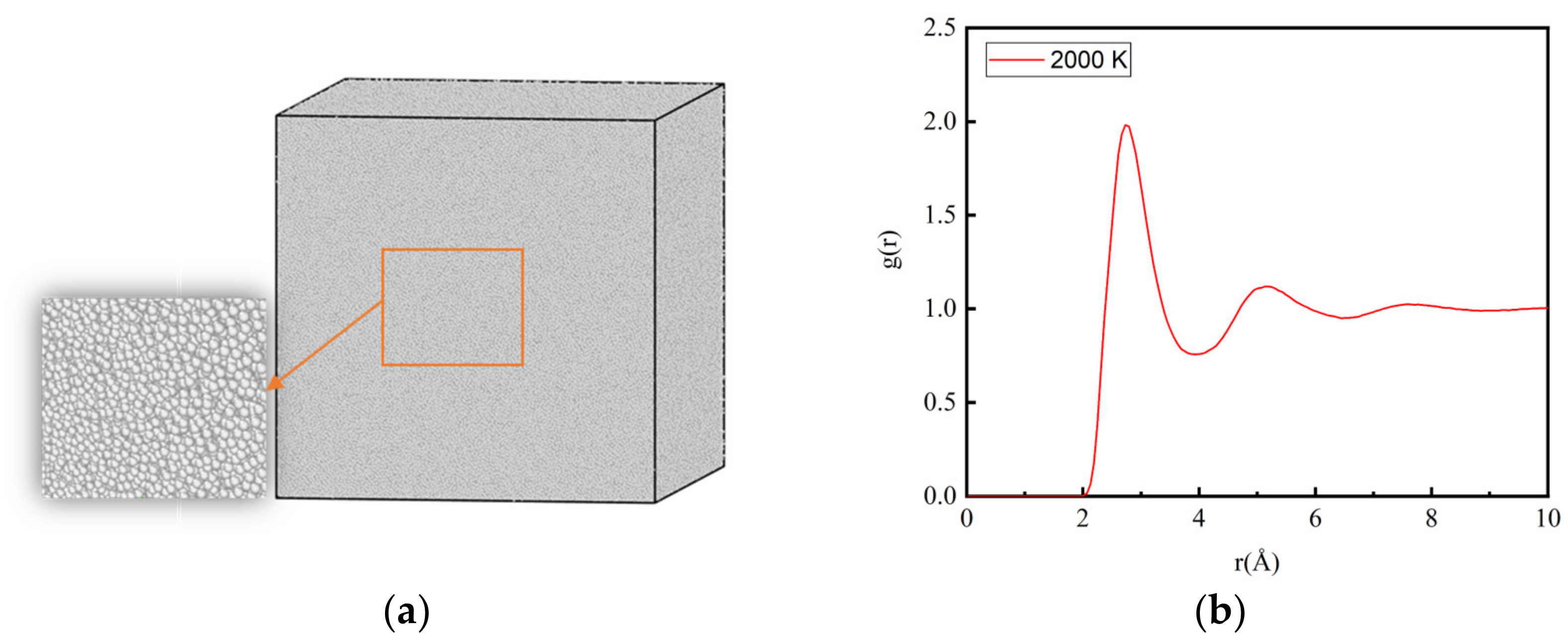


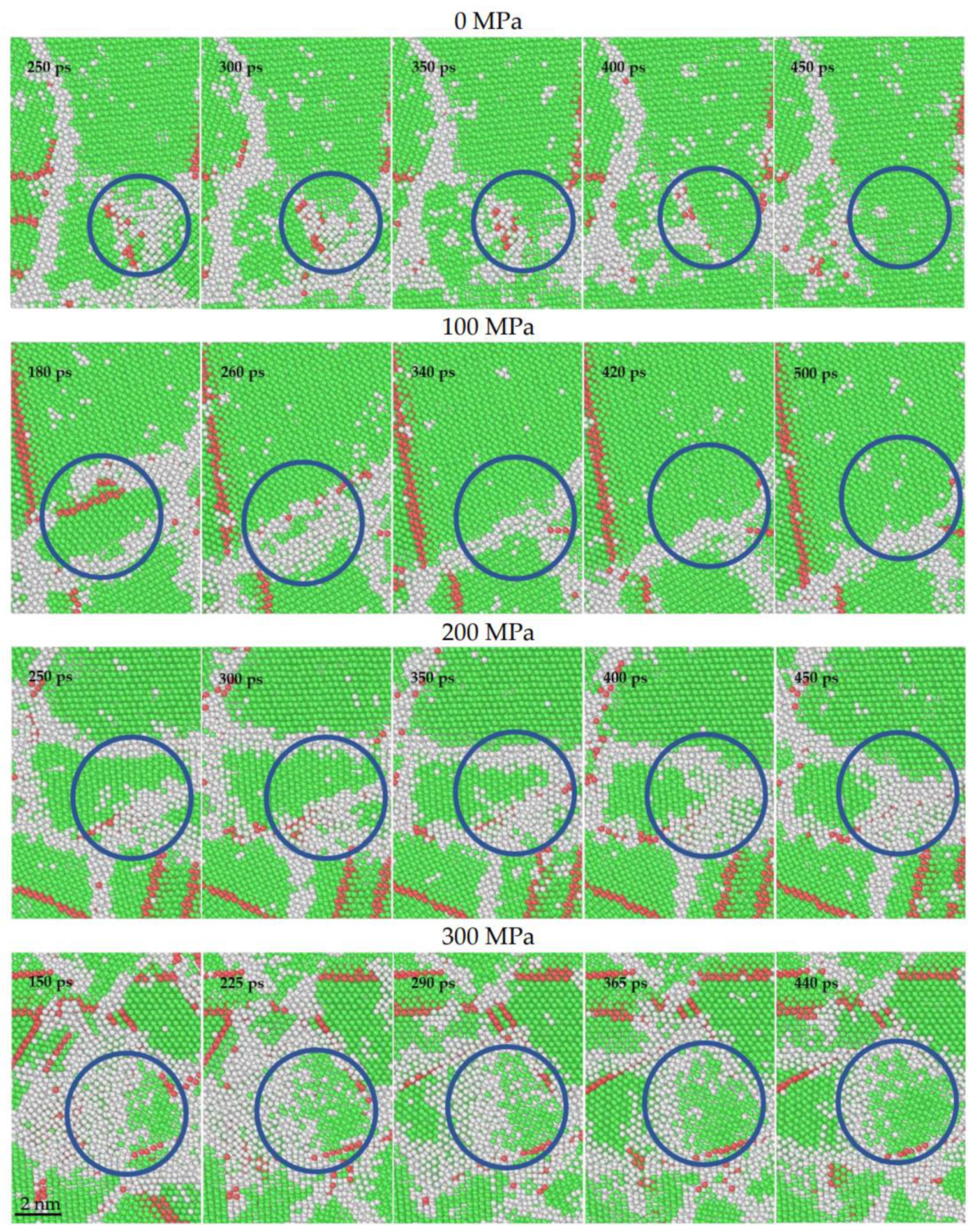
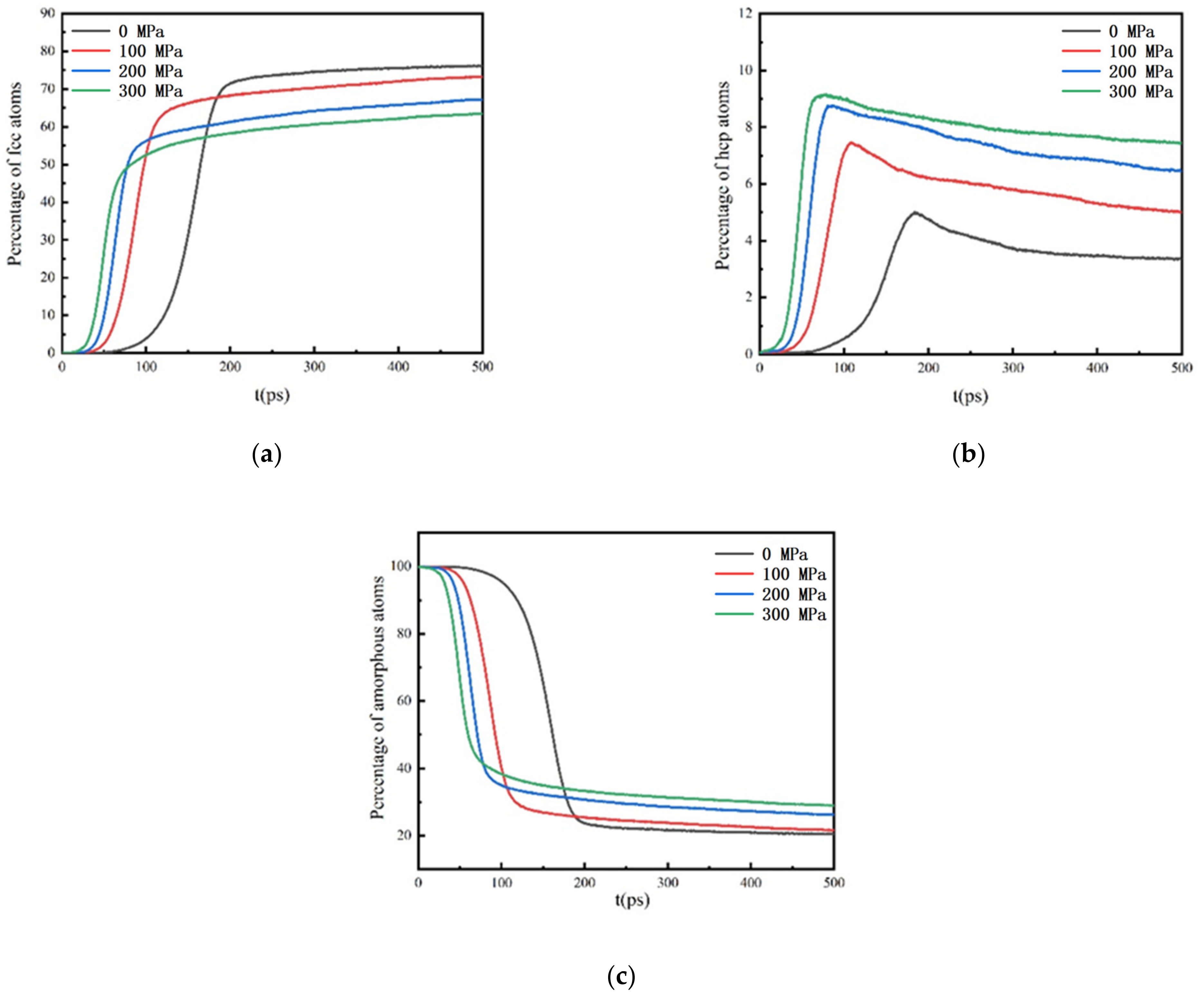

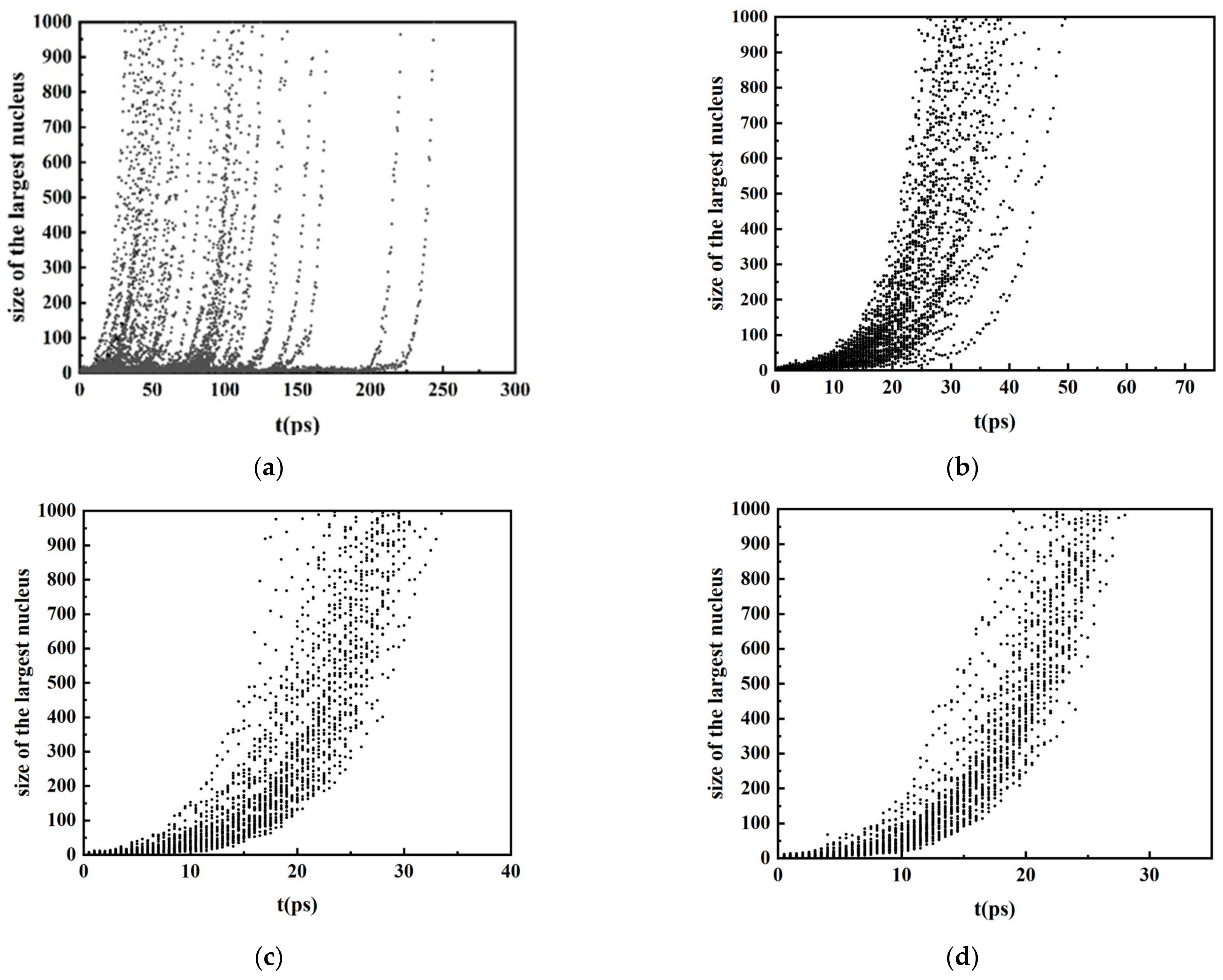
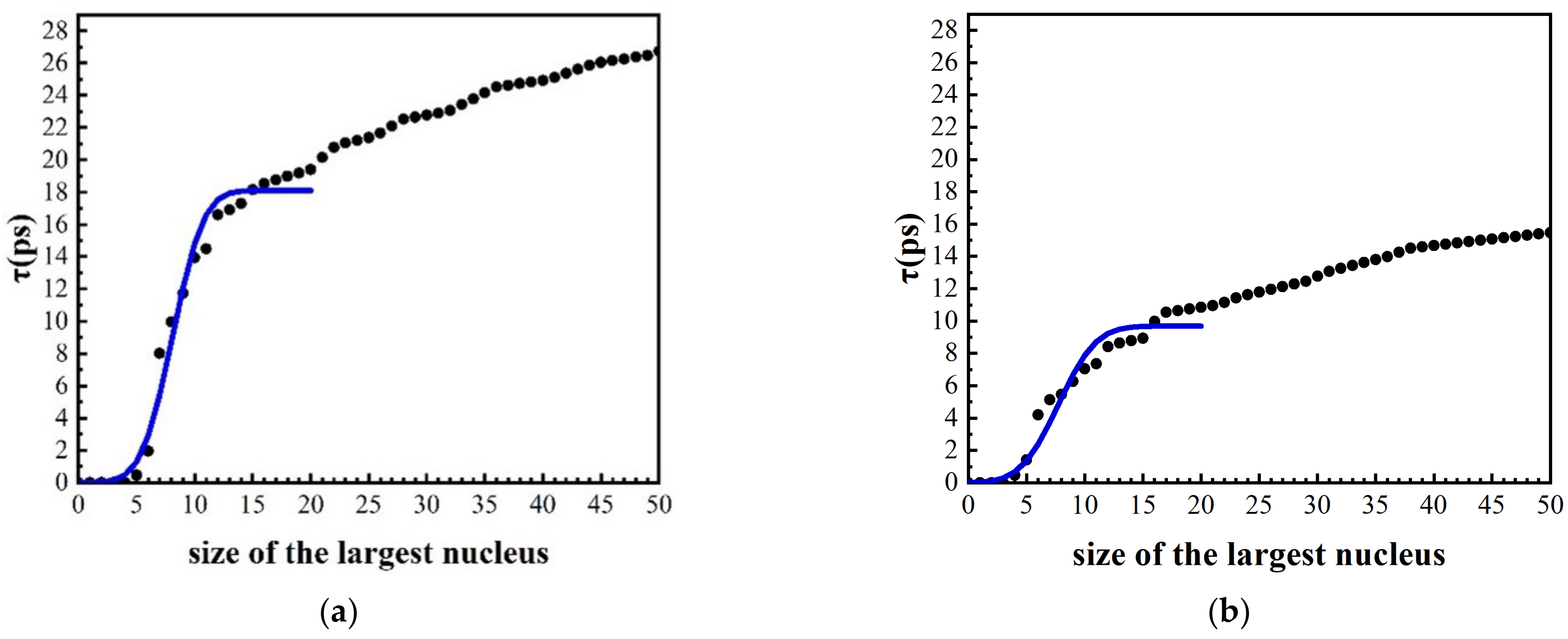

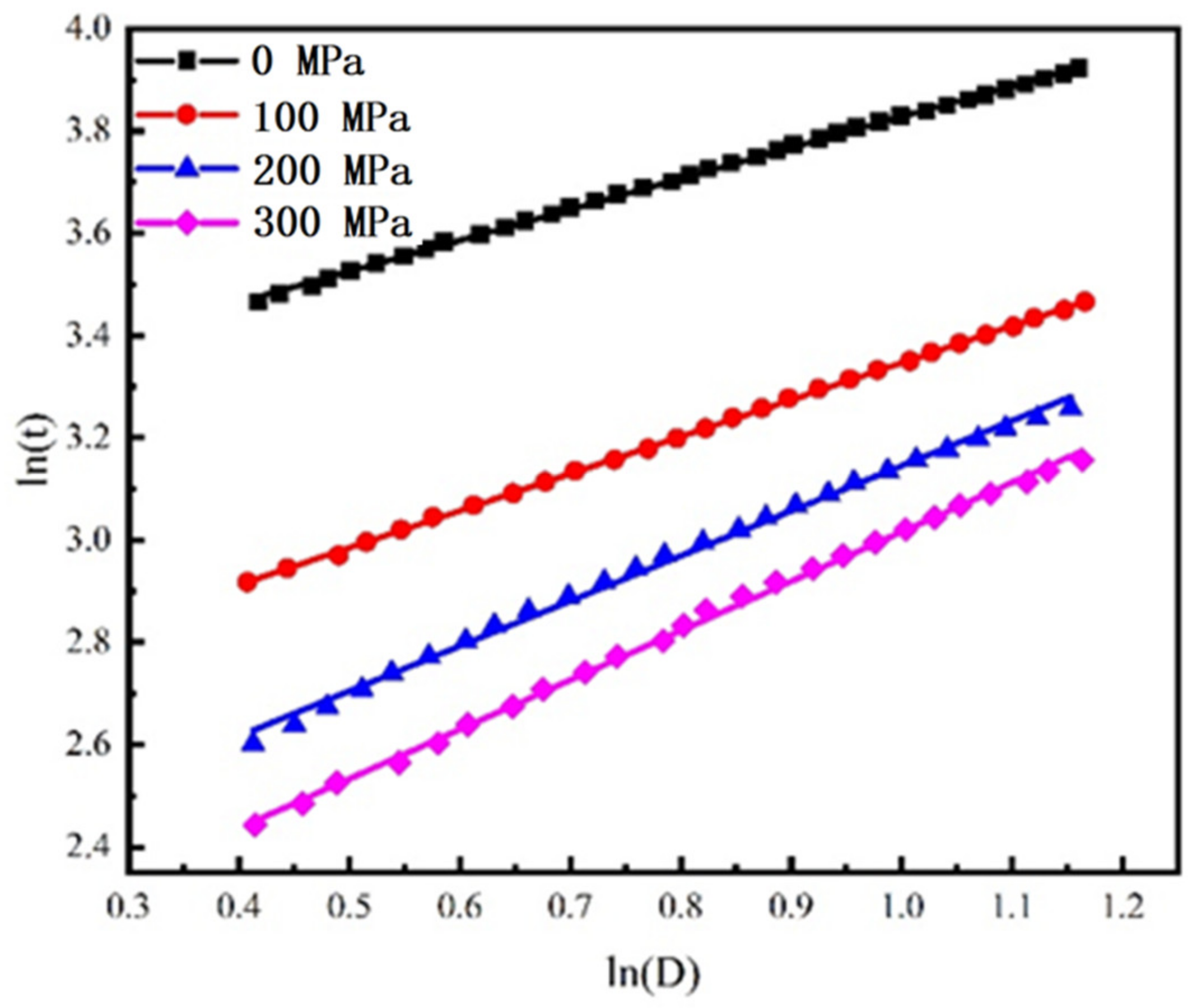
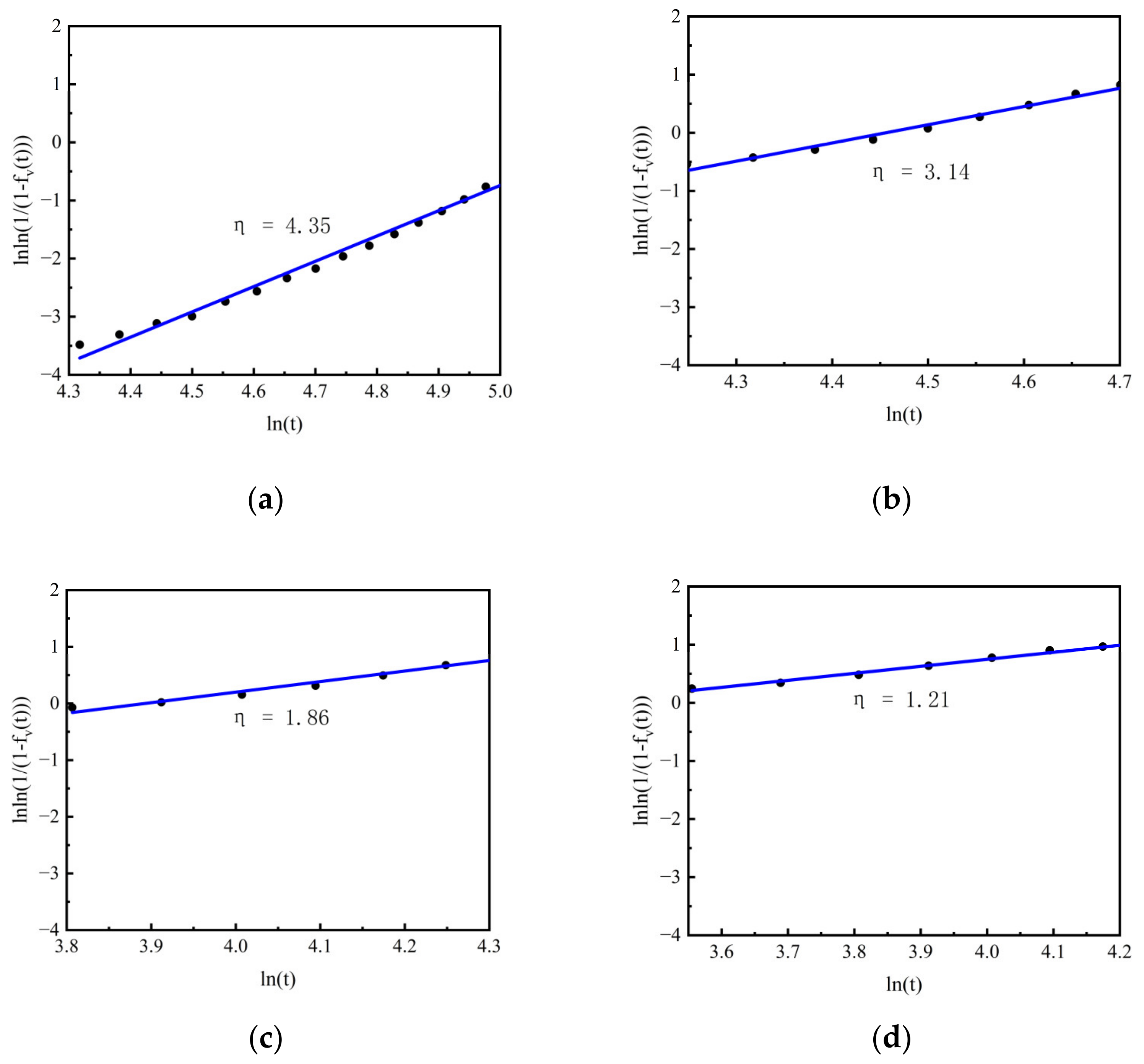
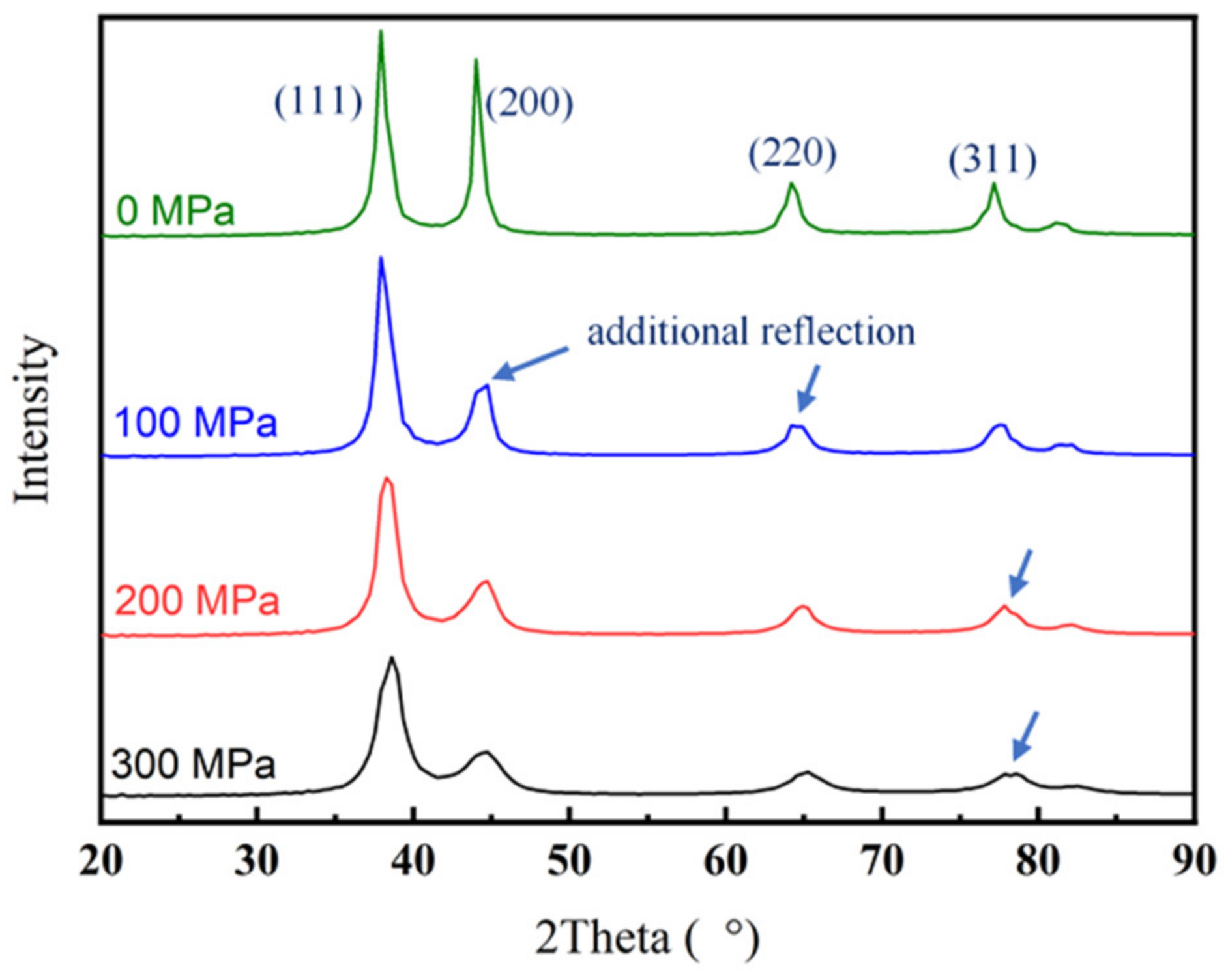
| Pressure (MPa) | (m−3s−1) | ||
|---|---|---|---|
| 0 | 8.09 | 3.05 × 1033 | ~0.32 |
| 100 | 7.75 | 5.77 × 1033 | ~0.32 |
| 200 | 7.49 | 1.17 × 1034 | ~0.31 |
| 300 | 7.07 | 1.62 × 1034 | ~0.31 |
| Pressure (MPa) | Crystallite Size (nm) |
|---|---|
| 0 | 12.01 |
| 100 | 9.45 |
| 200 | 8.01 |
| 300 | 7.29 |
Publisher’s Note: MDPI stays neutral with regard to jurisdictional claims in published maps and institutional affiliations. |
© 2022 by the authors. Licensee MDPI, Basel, Switzerland. This article is an open access article distributed under the terms and conditions of the Creative Commons Attribution (CC BY) license (https://creativecommons.org/licenses/by/4.0/).
Share and Cite
Chen, X.; Fan, W.; Jiang, W.; Lin, D.; Wang, Z.; Jiang, S. Effects of Pressure on Homogeneous Nucleation and Growth during Isothermal Solidification in Pure Al: A Molecular Dynamics Simulation Study. Metals 2022, 12, 2101. https://doi.org/10.3390/met12122101
Chen X, Fan W, Jiang W, Lin D, Wang Z, Jiang S. Effects of Pressure on Homogeneous Nucleation and Growth during Isothermal Solidification in Pure Al: A Molecular Dynamics Simulation Study. Metals. 2022; 12(12):2101. https://doi.org/10.3390/met12122101
Chicago/Turabian StyleChen, Xiaohua, Weijie Fan, Wenwen Jiang, Deye Lin, Zidong Wang, and Simeng Jiang. 2022. "Effects of Pressure on Homogeneous Nucleation and Growth during Isothermal Solidification in Pure Al: A Molecular Dynamics Simulation Study" Metals 12, no. 12: 2101. https://doi.org/10.3390/met12122101
APA StyleChen, X., Fan, W., Jiang, W., Lin, D., Wang, Z., & Jiang, S. (2022). Effects of Pressure on Homogeneous Nucleation and Growth during Isothermal Solidification in Pure Al: A Molecular Dynamics Simulation Study. Metals, 12(12), 2101. https://doi.org/10.3390/met12122101







